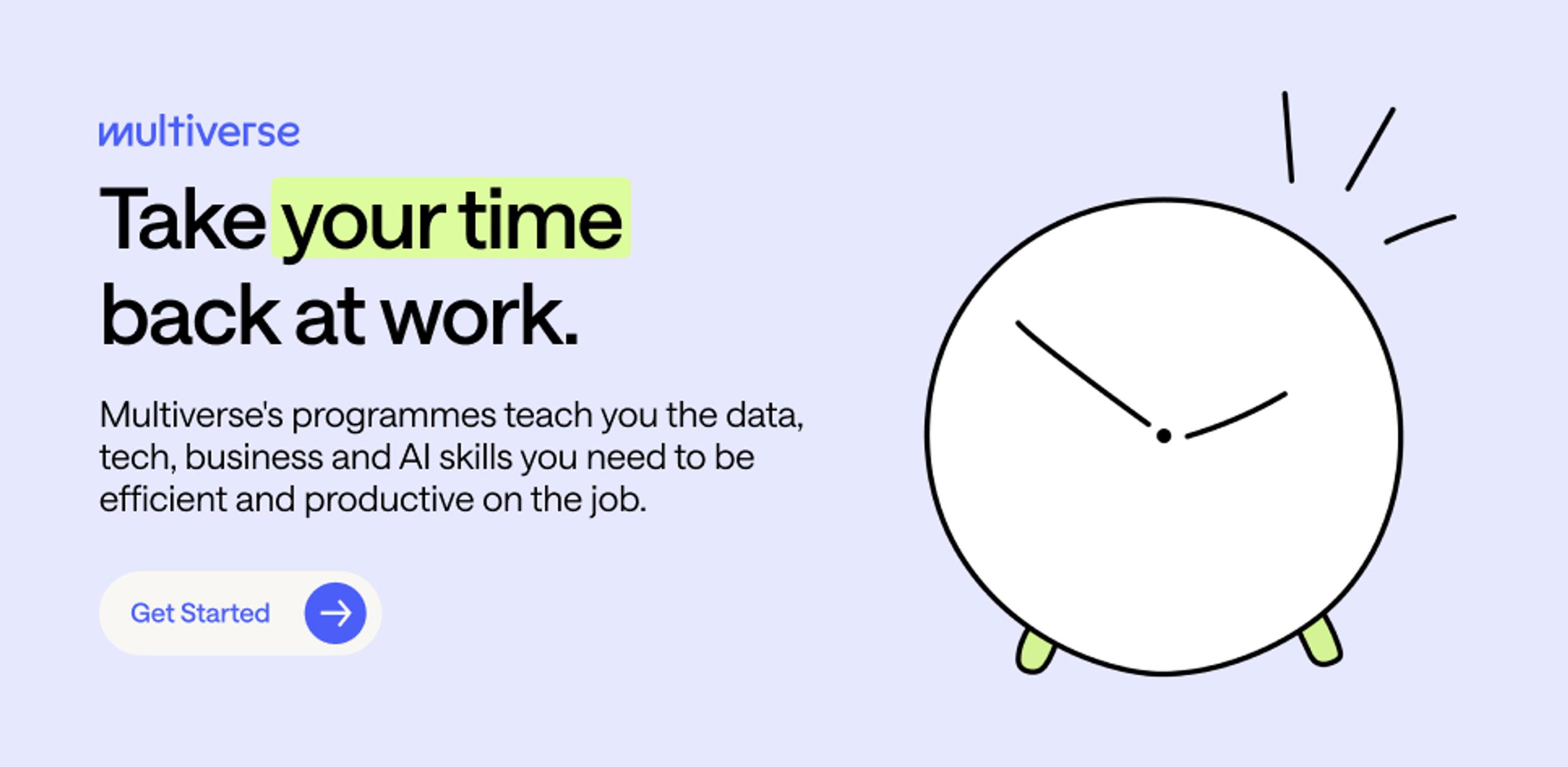Contents
Artificial intelligence (AI) isn’t quite as widespread in the workplace as tools like videoconferencing or Microsoft Office — but it’s getting there fast. Multiverse’s ROI of AI report(opens new window) found that 27% of organisations have already fully integrated AI, while another 51% are actively exploring its applications.
You might assume that tech experts are behind this rapid adoption, but that’s not strictly true. Sure, plenty of Machine Learning Engineers and other specialists are using advanced AI tools. But people across all roles and experience levels are taking advantage of it, too. With so many beginner-friendly options, AI is truly a jack-of-all-trades kind of technology.
This guide breaks down the best AI tools for your everyday work. We’ve got something for everyone — from marketers to analysts, career changers to developers, and paid or free users.
What are AI tools? A quick primer for beginners
AI tools include any software that’s powered by machine learning or large language models (LLMs). These applications use complex algorithms — or snippets of code — to process data and perform tasks.
While artificial intelligence is still relatively new, developers have already created many types of tools, including:
- Automation software
- Chatbots
- Code assistants
- Image recognition software
- Task management tools
- Text and image generators
Contrary to popular belief, most AI software doesn’t require any technical skills. All you need is a little curiosity and the willingness to experiment.
Must-have AI tools for everyday workflows
Popular AI tools like ChatGPT and Microsoft Copilot have quickly become household names, even for non-techies. But these applications only scratch the surface of everything that’s available.
Here are seven types of AI tools to consider adding to your work routine. Some are ground-breaking AI models, while others are familiar software with new AI powered features. Together, they can help you jumpstart your creativity and reach new levels of productivity.
Writing and content creation
Even the most creative people can sometimes feel bogged down by the writing process. Brainstorming, drafting, editing, then drafting again — it’s a lot of work, to put it mildly. Content creation tools can help you speed up these steps and improve the overall quality.
For a free AI writing tool, you can’t go wrong with the classic ChatGPT(opens new window). It’s perfect for brainstorming ideas for virtually any type of content. For instance, you could ask it to generate social media captions with prompts like, “Suggest 10 pun-filled captions for a photo of a golden retriever eating an ice cone.” Or request content ideas for how-to videos and email newsletters.
ChatGPT can also generate long form content, such as:
- Case studies
- Ebooks
- Entire blog posts
- White papers
- YouTube scripts
Meanwhile, Jasper.ai(opens new window) is designed for marketing teams. This AI writing assistant learns your brand voice and generates marketing copy that matches it flawlessly. With over 90 built-in marketing apps, it can create product descriptions, blog posts, and more.
AI tools assist with the editing process, too. Grammarly(opens new window) and Wordtune(opens new window) correct grammar mistakes and help maintain a consistent tone. Both applications integrate with Google Docs, so you don’t even need to switch to a new platform to check for mistakes.
Most content creation tools have free versions with basic features. But it’s often worth investing in paid plans for custom, high quality outputs.
Visuals and creative assets
Most businesses need a virtually endless supply of creative assets. For example, if you plan to publish two social media posts a week, you’ll need over 100 images or videos a year. Producing all this content with traditional tools can be incredibly time-consuming. That’s why many companies are turning to AI for assistance.
Canva’s Magic Design(opens new window) is one of the best AI image generators for beginners. All you need to do is describe what you want to see with text, and voila — you’ve got dozens of matching images. This platform is the ideal tool for creating social graphics and stylish slide decks for presentations.
DALL-E(opens new window) and Midjourney(opens new window) are slightly more advanced image generation tools. Like Canva, they create visuals based on written prompts. Their outputs can vary drastically based on how you phrase your request, so take the time to experiment with different inputs.
And don’t overlook video creation platforms like Lumen5(opens new window) and InVideo(opens new window). They let you generate short films based on text — no video editing skills or cameras required.
Productivity and admin
Every career involves repetitive or just plain tedious tasks. For instance, you might respond to the same customer questions over and over. (“How long will it take my product to ship?”) An AI assistant can automate this busy work, so you can focus on more meaningful activities.
Here are some of the best AI productivity tools:
- Notion AI(opens new window) is a great tool for summarising meetings and planning tasks.
- Otter(opens new window) and Fireflies(opens new window) automatically transcribe audio files and recap meetings
- Superhuman(opens new window) and Sanebox(opens new window) use AI to help you manage your inbox and draft emails.
These handy applications can significantly shrink your to-do list, reducing stress. Plus, they help prevent errors, like forgetting to respond to your boss’s urgent email or overlooking an action item after a standup meeting.
Project and task management
No matter your career stage or role, chances are you work on complex projects with a lot of moving parts. Use these AI powered project management tools to stay organised and meet deadlines:
- Trello(opens new window)’s AI features include intelligent task suggestions and decision-making tools.
- ClickUp(opens new window) is one of the best AI tools for task management and reporting.
- Asana AI(opens new window) automates tasks, generates status updates, and suggests next steps.
- Slack AI(opens new window) improves team collaboration by summarising conversations and answering questions about projects.
Coding and technical work (for beginners, too)
AI software can also assist with technical tasks. The best part? Most of these tools don’t require in-depth coding knowledge.
The majority (91%) of Web Developers(opens new window) now use AI tools to generate code. One of the most popular applications is GitHub Copilot(opens new window), which analyses your code and offers suggestions to improve it. Essentially, it’s a co-writer that helps you program faster. It also detects and fixes bugs, allowing you to create more accurate code.
Similarly, Replit’s Ghostwriter(opens new window) automatically completes your code and explains how other developers’ applications work. This AI assistant is especially helpful for junior developers who want to learn by doing.
AskCodi(opens new window) is another AI coding assistant that automates small tasks. For example, you can use this application to generate code snippets and write documentation.
Data and analysis
The average professional spends around 14 hours a week completing data tasks — yet over four of those hours are spent working inefficiently, according to the Multiverse Skills Intelligence Report.
The good news is that there are plenty of user-friendly AI tools that can help you analyse data more efficiently, including:
- ChatGPT can generate Excel formulae to manage complex spreadsheets.
- MonkeyLearn(opens new window) is a no-code platform for text processing. It lets you analyse sentiment in emails, social media posts, and other qualitative datasets.
- Power BI(opens new window) and Tableau(opens new window) offer AI powered features like forecasting and intelligent data visualisations.
In the UK, the demand for data skills(opens new window) has increased by 158% since 2013. These AI tools can help you future-proof your career(opens new window) and take on more advanced, data-driven responsibilities.
Career and personal growth
UK businesses in all industries are facing a critical digital skills gap(opens new window). Artificial intelligence can help you develop new abilities and attract the attention of potential employers.
Expand your skill set with Multiverse’s AI Skills Jumpstart course. This module covers fundamental AI skills like prompt engineering and data modelling. It also teaches you how to ethically use this technology in your daily workflows.
When you’re ready for a new role, optimise your job materials with LinkedIn(opens new window)’s free AI resume builder. Or use Rezi(opens new window) to write cover letters and resumes. Just be sure to add your own voice to the final versions. Employers can sniff out purely AI generated content immediately, and they might overlook your application if they think you didn’t put in any effort.
How to choose the right AI tools for your role
With so many options, it’s natural to feel a little lost. Overwhelmed, even. But you don’t need to try every tool at once.
Start by researching how other professionals in your field are using artificial intelligence. You’ll find plenty of industry-specific conversations about this technology on LinkedIn, online forums, and even podcasts. Surveys can also provide valuable insights about what works — and what doesn’t.
In the marketing industry, for instance, UK professionals already use AI content generators to create 36% of their social media content(opens new window). Meanwhile, Data Analysts typically rely on AI tools to automate tasks like cleaning and processing datasets.
Once you’ve got a sense of how AI tools work in your sector, you can begin assembling your toolkit. Choose platforms that offer a free tier or detailed demos so you can make sure they meet your needs before committing to a paid plan.
Here are a few AI starter packs for different careers:
Marketers:
- A large language model (ChatGPT, Jasper) to assist with the content creation process and prevent writer’s block
- Ocoya(opens new window) for social media management and AI generated content
- Midjourney for speedy image generation
- SEO.AI(opens new window) for keyword research and AI writing assistance
- Invideo for video generation
Analysts:
- Tableau for sophisticated data analysis and accessible AI models
- KNIME(opens new window) for predictive analytics and data modelling
- Canva Magic Design to present findings to business leaders and stakeholders
Software Developers:
- GitHub Copilot for fast and accurate coding
- ClickUp to manage Agile workflows
- Figstack(opens new window) to explain code and automatically translate it to another programming language
But don’t get too caught up in other people’s recommendations. Ultimately, AI tools should help you do your job, not someone else’s. In other words, don’t spend time learning Midjourney if a Graphic Designer handles most of your organisation’s creative assets.
Building real-world experience with AI tools
There are plenty of free tutorials and other resources for artificial intelligence platforms. However, reading about this technology can only take you so far. To truly understand its potential and limitations, you must actually apply it in your work routine.
A Multiverse apprenticeship lets you practise using AI tools in real business settings. You’ll learn how to integrate software like ChatGPT and project management AI in your existing role. This might involve automating some of your workflows (goodbye, repetitive data entry) or using an AI writing assistant to generate ideas.
Apprentices also build their skills with industry-specific tools. For instance, the 13-month Data Fellowship teaches you how to use PowerBI and Tableau for advanced data analytics. By contrast, the AI for Business Value apprenticeship focuses on data modelling and productivity tools.
Multiverse apprenticeships are fully paid for by employers and include protected time for on-the-job learning. They’re an excellent way to upskill without interrupting your career.
Learning how to use AI tools benefits your organisation, too. According to the ROI of AI report, approximately half of tech leaders say their businesses lack critical skills, such as data analytics and the ability to implement AI projects. By expanding your personal skill set, you can help close that gap and drive change within your organisation.
Best practices for integrating AI models and tools into your work
Experimenting with new technology is always thrilling, but don’t rush into adopting AI tools. Follow these guidelines to make sure you’re using it responsibly and effectively:
- Double-check all AI outputs: Like humans, AI can make silly or even dangerous mistakes. For example, AI generated content sometimes contains misleading medical advice(opens new window). Always review and improve outputs to protect your clients and reputation.
- Use thoughtful prompts: Content creation tools are only as effective as the inputs you provide. Always give the software the necessary context and request a specific tone. You can also explain your goals — “I want to persuade my target audience of 30-something pet owners to buy my leashes” — to help the AI generate the most relevant content.
- Set ethical boundaries: According to Forbes, one in three Brits (37%)(opens new window) feel concerned about the ethical implications of artificial intelligence. You can soothe these anxieties by prioritizing consent and transparency. Always ask customers for permission before inputting their data into AI tools, and clearly explain how you plan to use this technology. You should also carefully review AI generated content for any signs of bias, such as only creating images of one race or gender.
- Encourage consistency: AI tools work best when you treat them as part of your routine, not a novelty. For example, you might summarise meeting notes every Friday with Otter or generate social media posts twice a week.
Multiverse and the future of work
It’s no secret that artificial intelligence is accelerating and transforming the way we work. The IPPR(opens new window) predicts that this technology may disrupt up to 8 million jobs in the UK over the next few years.
The right training can help you adapt to these changes and stay competitive. While it’s possible to learn many AI tools on your own, Multiverse’s structured apprenticeships are the best way to gain hands-on experience. Our structured curricula teach you how to apply artificial intelligence in business and technical environments. You’ll also receive one-on-one mentorship and career coaching from industry experts to help you achieve your goals.
Our AI Jumpstart module is the fastest way to gain foundational knowledge and skills. You’ll learn how to use this technology to generate ideas, solve problems, and more. For more in-depth training, consider our Data Fellowship or Business Transformation Fellowship.
Start small, experiment often, and upskill along the way
Developers may have originally created artificial intelligence, but it’s no longer their exclusive domain. Anyone can benefit from this technology. AI image generators, productivity tools, video editing software — there’s truly something for everyone.
Join the tech revolution by experimenting with two or three free AI tools from our list. As you gain confidence, you can gradually expand your repertoire and try even more sophisticated software.
Or maybe you’re ready to deepen your knowledge and learn more about the theory behind this technology. A Multiverse apprenticeship could be exactly what you’re looking for. Explore our free AI programmes, or fill out our quick application today(opens new window).







